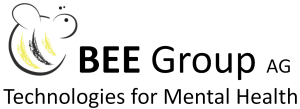Using the EEG in neurotherapy
Neurofeedback is a computer-aided, EEG-based method in which selected parameters of the patient´s own brain activity, which can normally not be perceived, are made accessible to the patient via the senses, e.g. by means of an audio-visual animation.
The BEE Group focuses on developing practicable systems based on years of experience and a very large number of cases.
The group maintains cooperations with clinical research centers and invests in the development of powerful devices and software.
The three points run hand-in-hand in the BEE Group:
Support of Psychotherapy by Uses of the EEG
In the area of neurotherapy the term „neurofeedback“ is becoming more and more common. During neurofeedback, the brain’s activity is measured as an EEG on the patient’s scalp and then, after appropriate signal processing, presented to the patient’s senses, e.g. by means of an audio-visual animation. It is important to note that during neurofeedback there are no electrical currents (e.g. tDCS) or magnetic fields (e.g. TMS) that are directed into the brain. The patient’s brain is instead presented with information it created itself in a way that it will learn to improve its auto-regulation capacity by interacting with the process.
Therapy of mental illness using the EEG: The beginnings in the 1960s
This kind of neurofeedback was discovered rather by accident during research on epilepsy by Barry Sterman in the late 1960s. During these experiments it was found that laboratory cats which were previously used in experiments which explored the operant conditioning of EEG were significantly less susceptible to epilepsy provoking substances than those which had not received neurofeedback. The results of this investigation were so impressive that one of Sterman’s assistants, who suffered from severe epilepsy, volunteered to receive neurofeedback – with astonishing success. The results of this experiment were published in 1972, and are seen as the “birth certificate” of clinical neurofeedback.
In the following years, other groups of researchers have explored neurofeedback. It didn’t take long for first indications of positive effects on individuals suffering from sleep disorders, attention disorders (including many comorbidities) as well as anxiety disorders, panic attacks, substance addictions and depressions.
Due to the lack of an explanation as to why this works, as well as the limited technical possibilities, neurofeedback was initially not accepted as a treatment.
Modern neurofeedback – operant conditioning as an explanation?
Only modern computer technology and the further developments in signal processing have allowed further research in the area of neurofeedback, which in turn allowed for further remarkable progress. Since 2010 the number of studies has grown significantly and neurofeedback is being used more and more with continued success.
The reason why it works, however, is still not very well understood – similar to certain medical interventions, which are widely used. Based on the original experiments by Barry Sterman, operant conditioning was used to explain neurofeedback. One reason may be that the basic idea behind it – measuring an EEG and using it to control some form of feedback – hasn’t changed. However, neurofeedback has evolved since then, and diversified into different types using different methods and different kinds of signal processing. These types are thoroughly documented. How effective they are, however, depends on a number of parameters.
In terms of clinical applications of neurofeedback, it was shown in the 1990s that the classical model of operant conditioning is not sufficient to explain the sudden and intense effects caused by neurofeedback.
The question as to how the self-organizing dynamic system “brain” interacts with itself through the process of neurofeedback, and the configuration of parameters such as electrode positions and frequency bands affects these processes arises more and more – especially in the field of therapeutic application.
Advanced understanding of neurofeedback through the model of dysregulation
In order to explain the effectiveness of neurofeedback the model of dysregulation is becoming more prevalent. According to this model the brain is constantly processing two tasks that are relevant for neurofeedback:
- The arousal states of the entire brain are being regulated in such a way that they are always appropriate to the situation (e.g. concentrating on a discussion or exam, or being relaxed or sleeping). When this self-regulation is not functioning properly a multitude of symptoms can result (e.g. sleep disorder, restlessness, the inability to focus on a task or specific forms of pain), which also occur as symptoms of mental illness. If the brain can be successfully trained to improve its ability to regulate itself this could be an explanation as to why symptoms of many different disorders and illnesses can be mitigated through neurofeedback.
- The brain is constantly on the search for ways in which it can interact with the outside world. When it finds a correlation it begins to interact with that process. In order to underline what is meant by this an example is useful: imagine a mirror that is in a lively place. Despite the many stimuli around us we would recognize our mirror image as special, and begin to interact with it (e.g. by waving to ourselves, tidying up our hair and the like). As soon as we discover such a relevant and unusual stimulus it immediately has our attention and we immediately begin to interact with it.
This circumstance is also used in modern neurofeedback: by feeding the brain relevant elements of its own activity, it will begin to interact with this process. This effect can be used for therapeutic processes.



